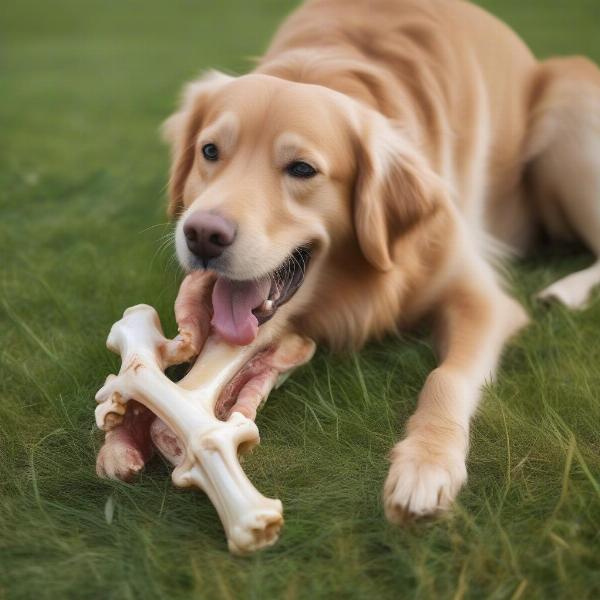Beef bones are a popular treat for dogs, offering a satisfying chew and potential dental benefits. However, not all beef bones are created equal, and some can pose serious health risks. This guide will explore the world of dog beef bones, covering safe options, potential hazards, and how to make this treat a healthy part of your dog’s life.
Understanding the Benefits and Risks of Beef Bones for Dogs
 Dog chewing a beef bone
Dog chewing a beef bone
Chewing on beef bones can provide several benefits for dogs, including mental stimulation, teeth cleaning, and jaw strengthening. The act of chewing releases endorphins, which have a calming effect. The abrasive action of gnawing on bones can help scrape away plaque and tartar buildup, promoting dental health. However, it’s crucial to be aware of the potential dangers. Cooked beef bones are a major no-no. They become brittle and can splinter, causing choking hazards, internal injuries, or blockages in the digestive tract.
Choosing the Right Beef Bones for Your Dog
Raw beef bones are generally safer than cooked bones, as they are less likely to splinter. However, even with raw bones, supervision is key. Opt for large, meaty bones that are too big for your dog to swallow whole. beef knuckle bones for dogs are an excellent choice, as are beef brisket bones for dogs. Avoid small, brittle bones, like those from poultry, and steer clear of weight-bearing bones, which are exceptionally dense and can damage your dog’s teeth.
Safe Chewing Practices for Your Dog
Always supervise your dog when they are chewing on a beef bone. Remove the bone after 15-20 minutes to prevent excessive chewing, which can lead to tooth wear. Discard any bones that have become small enough to be swallowed. Never give your dog a cooked beef bone.
What if My Dog Swallows a Bone Splinter?
If your dog swallows a bone splinter and exhibits signs of distress, like vomiting, diarrhea, or abdominal pain, contact your veterinarian immediately.
Alternatives to Beef Bones
If you’re concerned about the risks associated with beef bones, there are many safe and enjoyable alternatives available. These include rubber chew toys, nylon bones, and dental chews designed specifically for promoting oral health. raw beef marrow bones for dogs can offer a safer alternative while still providing the marrow dogs love.
Conclusion
Beef bones can be a rewarding treat for dogs, offering mental and physical benefits. However, it’s crucial to prioritize safety by choosing raw, appropriately sized bones and supervising chewing sessions. By following these guidelines, you can help ensure your furry friend enjoys this treat safely. Remember to consult with your veterinarian if you have any concerns about your dog’s diet or chewing habits.
FAQ
- Can puppies have beef bones? Yes, but choose soft, easily digestible bones like beef rib bones for dogs and always supervise them.
- How often can I give my dog a beef bone? Once or twice a week is generally sufficient.
- Are smoked beef bones safe for dogs? No, smoked bones often contain harmful chemicals and are more prone to splintering.
- What should I do if my dog breaks a tooth on a beef bone? Contact your veterinarian immediately.
- Can I give my dog a frozen beef bone? Frozen bones can be a longer-lasting chew, but they can also be harder on teeth. beef femur for dogs are best avoided as they can be too dense, even when frozen.
- Are there any specific breeds that should avoid beef bones? Dogs with strong jaws and a tendency to chew aggressively may be at higher risk of tooth fractures.
- What are the signs of a bowel obstruction from a bone? Vomiting, diarrhea, loss of appetite, and abdominal pain are common signs.
ILM Dog is your trusted source for expert dog care advice. We offer a wealth of information on dog breeds, health, training, nutrition, and more. Whether you’re a new dog owner or a seasoned pro, we’re here to help you provide the best possible care for your canine companion. Contact us today for expert advice and support! Email: [email protected] Phone: +44 20-3965-8624 Visit ILM Dog for more information.